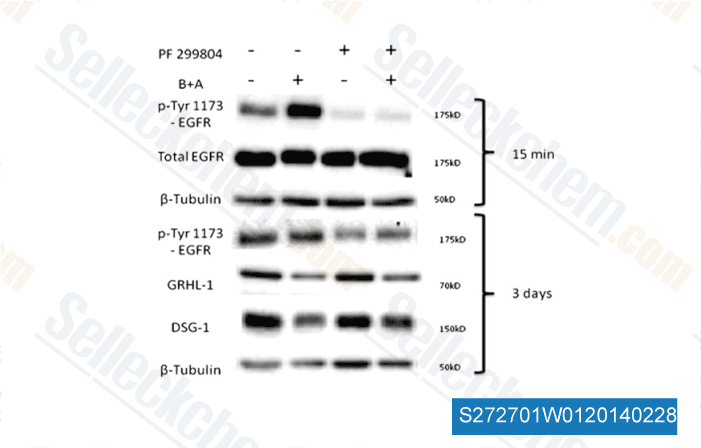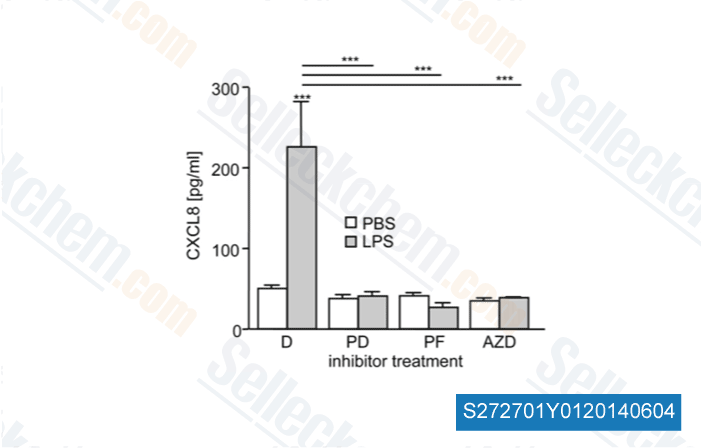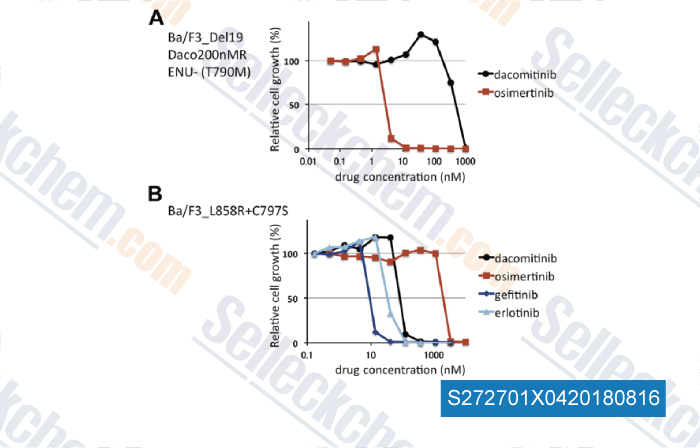|
Toll Free: (877) 796-6397 -- USA and Canada only -- |
Fax: +1-832-582-8590 Orders: +1-832-582-8158 |
Tech Support: +1-832-582-8158 Ext:3 Please provide your Order Number in the email. |
Technical Data
| Formula | C24H25ClFN5O2 |
|||
| Molecular Weight | 469.94 | CAS No. | 1110813-31-4 | |
| Solubility (25°C)* | In vitro | DMSO | 12.5 mg/mL (26.59 mM) | |
| Water | Insoluble | |||
| Ethanol | Insoluble | |||
|
* <1 mg/ml means slightly soluble or insoluble. * Please note that Selleck tests the solubility of all compounds in-house, and the actual solubility may differ slightly from published values. This is normal and is due to slight batch-to-batch variations. * Room temperature shipping (Stability testing shows this product can be shipped without any cooling measures.) |
||||
Preparing Stock Solutions
Biological Activity
| Description | Dacomitinib is a potent, irreversible pan-ErbB inhibitor, mostly to EGFR with IC50 of 6 nM in a cell-free assay. Dacomitinib inhibits ERBB2 and ERBB4 with IC50 of 45.7 nM and 73.7 nM, respectively. Dacomitinib is effective against NSCLCs with EGFR or ERBB2 mutations (resistant to gefitinib) as well as those harboring the EGFR T790M mutation. Dacomitinib inhibits cell growth and induces apoptosis. Phase 2. | ||||||
|---|---|---|---|---|---|---|---|
| Targets |
|
||||||
| In vitro | PF299804 is a specific inhibitor of the ERBB family of kinases. PF299804 inhibits EGFR signaling and induces apoptosis in the EGFR T790M-containing H3255 GR cell line. PF299804 is effective in gefitinib-sensitive and gefitinibresistant NSCLC cell lines. PF299804 inhibits the growth of H3255 and HCC827 cells engineered to express EGFR T790M. PF299804 inhibits EGFR phosphorylation in the presence of the T790M mutation. [1] PF-299804 is believed to irreversibly inhibit ERBB tyrosine kinase activity through binding at the ATP site and covalent modification of nucleophilic cysteine residues in the catalytic domains of ERBB family members. [2] PF299804 shows significant growth-inhibitory effects in HER2-amplified gastric cancer cells (SNU216, N87), and it has lower 50% inhibitory concentration values compared with other EGFR tyrosine kinase inhibitors, including gefitinib, lapatinib, BIBW-2992, and CI-1033. PF299804 induces apoptosis and G1 arrest and inhibits phosphorylation of receptors in the HER family and downstream signaling pathways including STAT3, AKT, and extracellular signal-regulated kinases (ERK) in HER2-amplified gastric cancer cells. PF299804 also blocks EGFR/HER2, HER2/HER3, and HER3/HER4 heterodimer formation as well as the association of HER3 with p85α in SNU216 cells. [3] A recent research uses forty-seven human breast cancer and immortalized breast epithelial lines to evaluate the inhibition effects of PF299804, the results indicate PF299804 preferentially inhibits growth of HER-2-amplified breast cancer cell lines than nonamplified lines (RR = 3.39, p < 0.0001). PF299804 reduces the phosphorylation of HER2, EGFR, HER4, AKT, and ERK in the majority of sensitive lines. PF299804 exerts its anti-proliferative effect through a combined G0/G1 arrest and an induction of apoptosis. [4] | ||||||
| In vivo | Orally administered PF299804 effectively inhibits growth of HCC827 Del/T790M xenografts. [1] Low oral administration of PF-299804 (15mg/kg) causes significant antitumor activity, including marked tumor regressions in a variety of human tumor xenograft models that express and/ or overexpress ERBB family members or contain the double mutation (L858R/T790M) in ERBB1 (EGFR) associated with resistance to gefitinib and erlotinib. [2] |
Protocol (from reference)
| Kinase Assay:[1] |
|
|---|---|
| Cell Assay:[1] |
|
| Animal Study:[1] |
|
References
Customer Product Validation

-
Data from [J Immunol, 2014, 192(2), 722-31]

-
Data from [J Immunol, 2014, 192(2), 722-31]

-
Data from [J Immunol, 2014, 192(2), 722-31]

-
Data from [Data independently produced by , , J Thorac Oncol, 2018, 13(5):727-731]
Selleck's Dacomitinib has been cited by 90 publications
| Signaling-induced systematic repression of miRNAs uncovers cancer vulnerabilities and targeted therapy sensitivity [ Cell Rep Med, 2023, S2666-3791(23)00367-1] | PubMed: 37734378 |
| Signaling-induced systematic repression of miRNAs uncovers cancer vulnerabilities and targeted therapy sensitivity [ Cell Rep Med, 2023, 4(10):101200] | PubMed: 37734378 |
| HER4 and EGFR activate cell signaling in NRG1 fusion-driven cancers: implications for HER2/HER3-specific vs. pan-HER targeting strategies [ J Thorac Oncol, 2023, S1556-0864(23)00802-X] | PubMed: 37678511 |
| Irreversible HER2 inhibitors overcome resistance to the RSL3 ferroptosis inducer in non-HER2 amplified luminal breast cancer [ Cell Death Dis, 2023, 14(8):532] | PubMed: 37596261 |
| Pan-HER inhibitors overcome lorlatinib resistance caused by NRG1/HER3 activation in ALK-rearranged lung cancer [ Cancer Sci, 2023, 10.1111/cas.15579] | PubMed: 36086904 |
| Pan-HER inhibitors overcome lorlatinib resistance caused by NRG1/HER3 activation in ALK-rearranged lung cancer [ Cancer Sci, 2023, 114(1):164-173] | PubMed: 36086904 |
| Multiscale Analysis and Validation of Effective Drug Combinations Targeting Driver KRAS Mutations in Non-Small Cell Lung Cancer [ Int J Mol Sci, 2023, 24(2)997] | PubMed: 36674513 |
| Irreversible tyrosine kinase inhibitors induce the endocytosis and downregulation of ErbB2 [ Biochem Biophys Rep, 2023, 34:101436] | PubMed: 36824069 |
| Poziotinib for EGFR exon 20-mutant NSCLC: Clinical efficacy, resistance mechanisms, and impact of insertion location on drug sensitivity [ Cancer Cell, 2022, 40(7):754-767.e6] | PubMed: 35820397 |
| A community challenge for a pancancer drug mechanism of action inference from perturbational profile data [ Cell Rep Med, 2022, 3(1):100492] | PubMed: 35106508 |
RETURN POLICY
Selleck Chemical’s Unconditional Return Policy ensures a smooth online shopping experience for our customers. If you are in any way unsatisfied with your purchase, you may return any item(s) within 7 days of receiving it. In the event of product quality issues, either protocol related or product related problems, you may return any item(s) within 365 days from the original purchase date. Please follow the instructions below when returning products.
SHIPPING AND STORAGE
Selleck products are transported at room temperature. If you receive the product at room temperature, please rest assured, the Selleck Quality Inspection Department has conducted experiments to verify that the normal temperature placement of one month will not affect the biological activity of powder products. After collecting, please store the product according to the requirements described in the datasheet. Most Selleck products are stable under the recommended conditions.
NOT FOR HUMAN, VETERINARY DIAGNOSTIC OR THERAPEUTIC USE.
